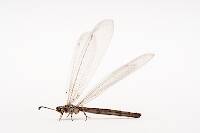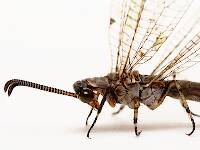
Blue-winged Olives
Baetis
Tiny Baetis mayflies are perhaps the most commonly encountered and imitated by anglers on all American trout streams due to their great abundance, widespread distribution, and trout-friendly emergence habits.
Featured on the forum

This specimen resembled several others of around the same size and perhaps the same species, which were pretty common in my February sample from the upper Yakima. Unfortunately, I misplaced the specimen before I could get it under a microscope for a definitive ID.

Troutnut is a project started in 2003 by salmonid ecologist Jason "Troutnut" Neuswanger to help anglers and
fly tyers unabashedly embrace the entomological side of the sport. Learn more about Troutnut or
support the project for an enhanced experience here.
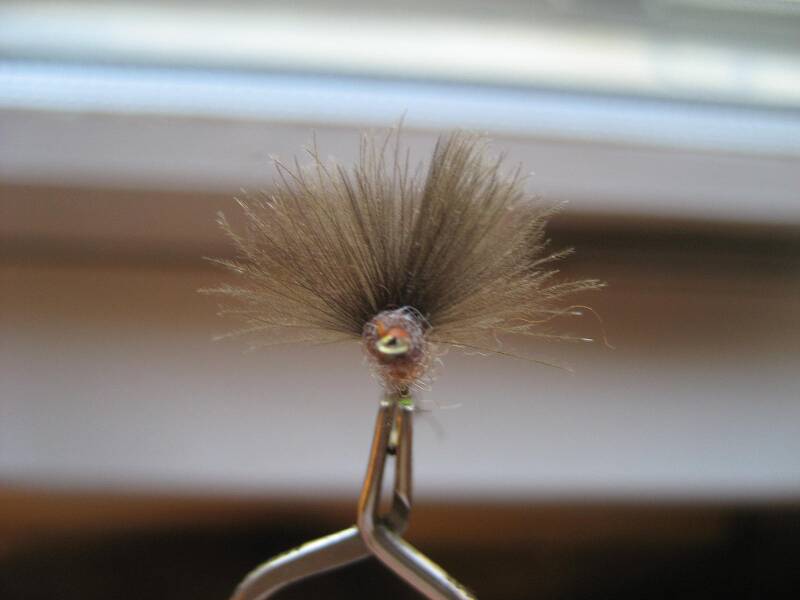
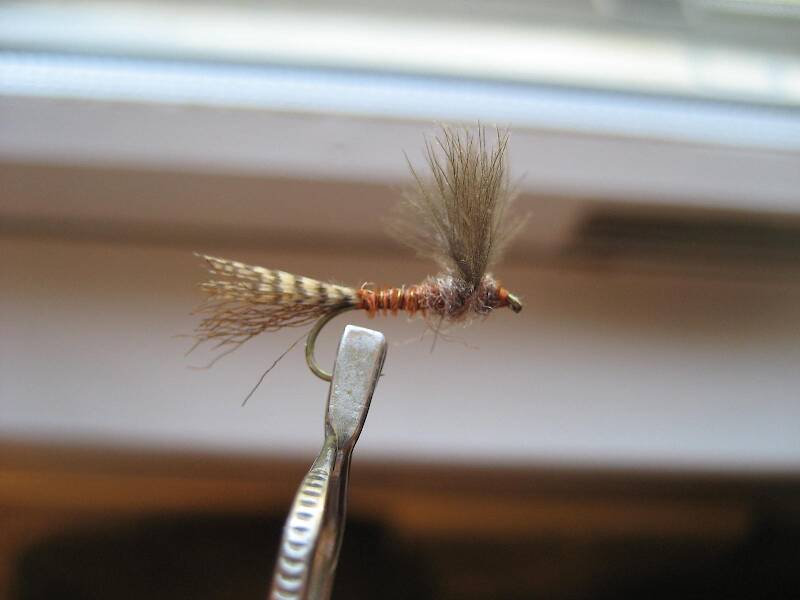
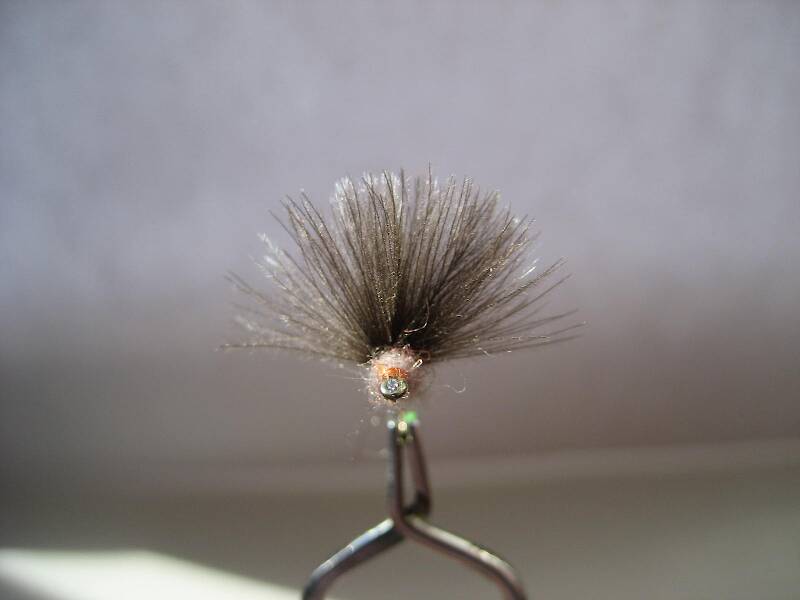
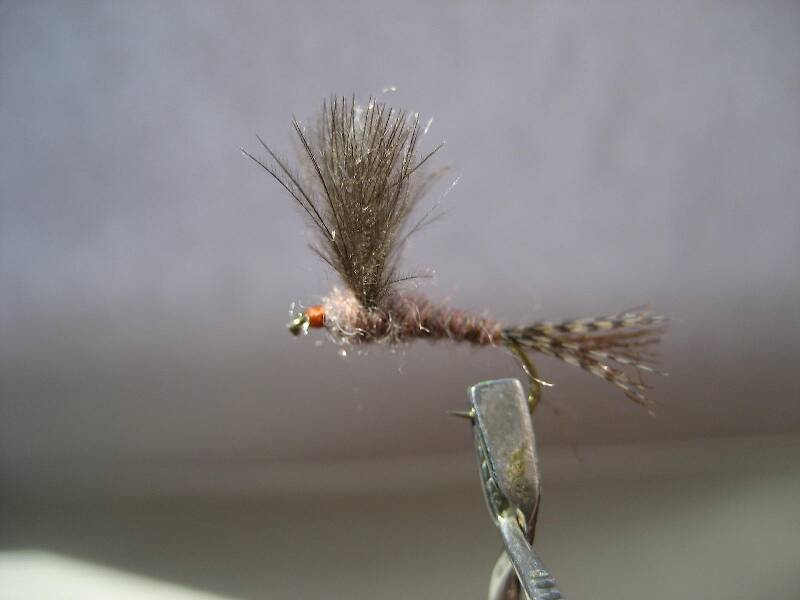
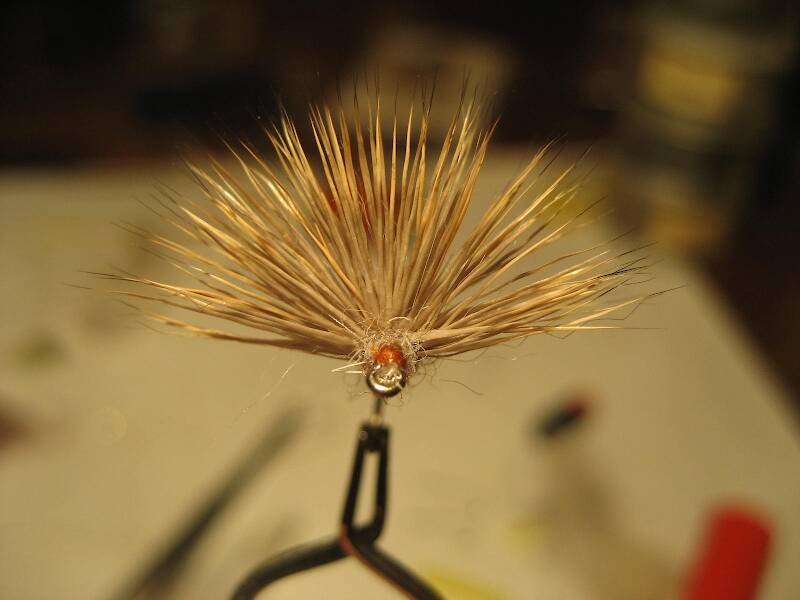
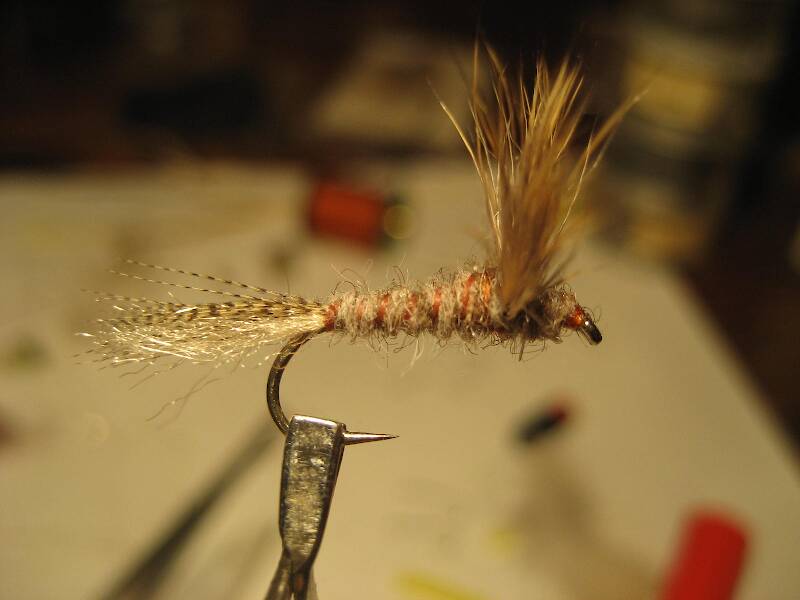
Entoman on Jan 27, 2012January 27th, 2012, 7:26 am EST
There are three ways to tie off a parachute hackle:
1. With the grain at the head.
2. Against the grain at the head.
3. At the base of the hackle on the post.
The first two methods must leave the hackle with some stem and fibers exposed dorsally unless you either tie a big head or have the post fairly close to the eye (neither solution is desirable). Most of the time, I prefer the third method as the neatest and most durable. Also allows for post placement anywhere you want it, even at the bend if you want to.
If you prefer to use one of the first two methods, a neat little trick to avoid trapping hackle without holding them back out of the way (which does break down stem/barbule strength to varying degrees, depending on hackle quality) is to shorten the bobbin right up to the hook shank to tie down the hackle. Done in this manner, the wraps are in tight and the bobbin tube being "inside" the hackle diameter prevents barbules from being trapped. After trimming, apply the whip using your forefinger to guide the wraps underneath the hackle and parallel to the shank as you come over the top.
1. With the grain at the head.
2. Against the grain at the head.
3. At the base of the hackle on the post.
The first two methods must leave the hackle with some stem and fibers exposed dorsally unless you either tie a big head or have the post fairly close to the eye (neither solution is desirable). Most of the time, I prefer the third method as the neatest and most durable. Also allows for post placement anywhere you want it, even at the bend if you want to.
If you prefer to use one of the first two methods, a neat little trick to avoid trapping hackle without holding them back out of the way (which does break down stem/barbule strength to varying degrees, depending on hackle quality) is to shorten the bobbin right up to the hook shank to tie down the hackle. Done in this manner, the wraps are in tight and the bobbin tube being "inside" the hackle diameter prevents barbules from being trapped. After trimming, apply the whip using your forefinger to guide the wraps underneath the hackle and parallel to the shank as you come over the top.
"It's not that I find fishing so important, it's just that I find all other endeavors of Man equally unimportant... And not nearly as much fun!" Robert Traver, Anatomy of a Fisherman
JOHNW on Jan 27, 2012January 27th, 2012, 11:25 am EST
I'm an inexperienced parachute tier! Never figured out how to tie off and not get my hackle fibers stuck in the whip finish. I am getting a little better.
Hmm I sense an opportunity ;)
I use the method Spence and Entoman describe in wrapping and tying off on the post.
If one insists on tying off behind the eye make sure to wrap thread and hackle in the same direction.
To finish I will substitute half hitches from the tip of a ball point pen for a whip. you can slide the pen right under the hackle and avoid all of the fibers. A drop of thinned cement can be added to the thread befor the halfhites are tied if you are worried about durability however my fly is apt to be lost long before that becomes and issue.
JW
"old habits are hard to kill once you have gray in your beard" -Old Red Barn
Entoman on Jan 27, 2012January 27th, 2012, 5:02 pm EST
If one insists on tying off behind the eye make sure to wrap thread and hackle in the same direction.
I agree with you JW, But there are some renowned tiers that would disagree with us. A.K. Best comes to mind as one example. He ties his with quill bodies wrapped right up to the base of the post and the hackle tied off right in front of the post. He ties it down against the grain so that he can snugly hold the hackle tight against the post and angling the tip towards the tail while tying down. This means his flies have a post very close to the eye and a head/tiny thorax of thread. To me those are negatives, but his style is very popular.
To finish I will substitute half hitches from the tip of a ball point pen for a whip.
Excellent advice. I don't think there is any loss of security if you use head cement. It seems to me that it would be the method to use for any tier that lacks the dexterity to whip the way I described.
"It's not that I find fishing so important, it's just that I find all other endeavors of Man equally unimportant... And not nearly as much fun!" Robert Traver, Anatomy of a Fisherman
Martinlf on Jan 27, 2012January 27th, 2012, 5:40 pm EST
Hi Matt,
Great looking flies, as always. JDo you sometimes stack the feathers with concave sides together? I seem to remember someone who stacked two concave then a third feather convex on top. Was that you?
ohn and I will be up April 21-22, and we'll be fishing with Bruce Miller on the 22nd. If you're there, it would be great to fish with you on the 21st.
--Louis
Great looking flies, as always. JDo you sometimes stack the feathers with concave sides together? I seem to remember someone who stacked two concave then a third feather convex on top. Was that you?
ohn and I will be up April 21-22, and we'll be fishing with Bruce Miller on the 22nd. If you're there, it would be great to fish with you on the 21st.
--Louis
"He spread them a yard and a half. 'And every one that got away is this big.'"
--Fred Chappell
--Fred Chappell
Wbranch on Jan 28, 2012January 28th, 2012, 2:28 am EST
Hello Louis,
"I seem to remember someone who stacked two concave then a third feather convex on top. Was that you?"
Yes, I confess that is me - but I do it on my downwing caddis flies - so the wings form that tent effect.
"I seem to remember someone who stacked two concave then a third feather convex on top. Was that you?"
Yes, I confess that is me - but I do it on my downwing caddis flies - so the wings form that tent effect.
Catskill fly fisher for fifty-five years.
Martinlf on Jan 28, 2012January 28th, 2012, 7:02 am EST
Thanks, Matt. Your tips are always spot on. Have you tried synthetics like zelon or hi-viz on any of your comparadun or caddis wings? It seems several guys on the D like them. I use CDC a lot myself, and some snowshoe as per your tie, but I wonder if the synthetics might be as effective and easier to float.
"He spread them a yard and a half. 'And every one that got away is this big.'"
--Fred Chappell
--Fred Chappell
Wbranch on Jan 28, 2012January 28th, 2012, 7:53 am EST
Hi Louis,
"but I wonder if the synthetics might be as effective and easier to float."
Yes, I have been tying some poly wings because you mentioned it to me about three years ago, I do it not for some potential floatation benefit but I tie very small compara-duns with z-lon or poly, much smaller than I can with hair. I can also tie compara-duns down to #22 with the CDC and the BWO in #20 - #22 with a little crinkle brown shuck, turkey biot body, and a robust fur thorax really look great and catch me lots of WB trout.
The other reason I have been using the z-lon or poly material is I can use two colors to emulate the leading edge of some of the mayfly wings. Right off the top of my head Ep dorothea duns sometimes seem to have a yellow leading edge on the wings. All of the PMD I see out west have the yellow edge to the wing. I use a double strand diameter of carded z-lon for the main color of the wing and I separate a strand of yellow and put it in front of the darker, and thicker, aft wing. I'll be honest that the yellow doesn't always "fan" nicely in front but sometimes it does and they look cool! Do they catch more fish? I doubt it but they are still fun to catch anyway.
The older I get the more I believe we can pare down our patterns, and fly boxes, to far fewer patterns than we typically take on the water with us. I just went through some of my dry fly and nymph boxes and pulled out over 100 flies that I'm going to give to some guys I know who don't tie.
I'd like to see you guys on the April weekend. I'm getting home from a week in the Dominican Republic on the 20th so just don't know if I'll have the time to get my stuff together and get up there unless I do it before I leave for the DR.
"but I wonder if the synthetics might be as effective and easier to float."
Yes, I have been tying some poly wings because you mentioned it to me about three years ago, I do it not for some potential floatation benefit but I tie very small compara-duns with z-lon or poly, much smaller than I can with hair. I can also tie compara-duns down to #22 with the CDC and the BWO in #20 - #22 with a little crinkle brown shuck, turkey biot body, and a robust fur thorax really look great and catch me lots of WB trout.
The other reason I have been using the z-lon or poly material is I can use two colors to emulate the leading edge of some of the mayfly wings. Right off the top of my head Ep dorothea duns sometimes seem to have a yellow leading edge on the wings. All of the PMD I see out west have the yellow edge to the wing. I use a double strand diameter of carded z-lon for the main color of the wing and I separate a strand of yellow and put it in front of the darker, and thicker, aft wing. I'll be honest that the yellow doesn't always "fan" nicely in front but sometimes it does and they look cool! Do they catch more fish? I doubt it but they are still fun to catch anyway.
The older I get the more I believe we can pare down our patterns, and fly boxes, to far fewer patterns than we typically take on the water with us. I just went through some of my dry fly and nymph boxes and pulled out over 100 flies that I'm going to give to some guys I know who don't tie.
I'd like to see you guys on the April weekend. I'm getting home from a week in the Dominican Republic on the 20th so just don't know if I'll have the time to get my stuff together and get up there unless I do it before I leave for the DR.
Catskill fly fisher for fifty-five years.
Martinlf on Jan 28, 2012January 28th, 2012, 4:11 pm EST
Cool, Matt. I've tied a few synthetic wing comparaduns myself, but have yet to use one. I always reach for the CDC or deer hair versions. But this year I vow to fish some with synthetic wimgs. I did run into a guy on the Firehole one sleety day who gave me one of his caddis tied with synthetic wings. It seemed easier to keep floating after a few fish than my CDC versions,though both caught me lots of trout that day. The bison finally ran me out of my spot, but I was pretty cold by then anyway.
"He spread them a yard and a half. 'And every one that got away is this big.'"
--Fred Chappell
--Fred Chappell
Wbranch on Jan 28, 2012January 28th, 2012, 6:12 pm EST
"It seemed easier to keep floating after a few fish than my CDC versions"
It is very surprising to me that the synthetic wing would float better than the CDC. Was the CDC Puffs or the longer feathers? I used to think the Puffs were so neat because there was virtually no center stem. I'd position it on top of the hook with a turn of thread then pull the end of the feather until I had the perfect wing length.
But I've found that they may look great dry they don't float well at all. They easily become waterlogged and can't be easily false cast dry. Also the wing profile becomes very slim when wet. The only way I've been able to rejuvenate them would be to bring in the fly, blot off the excess water, then brush dessicant all over it, blow it off, and then it would float for about 5 - 6 casts then I'd have to do it all over.
For a number of years now I've just been looking at the dozens of CDC Puff emergers in my boxes. Over the past two weeks I have been able to repair them by adding 2 - 3 tips from Trouthunter CDC, of a shade close to the Puff wing and I've been able to fix over three dozen flies in just about an hour and a half.
I had at least twelve packages of CDC Puffs and recently sent them to the fellow who was asking for help regarding fly tying material. They are still okay if you want to use them as trailing shucks or as underwings for EHC or as post wings for thorax duns but not to be used as the sole wing material.
It is very surprising to me that the synthetic wing would float better than the CDC. Was the CDC Puffs or the longer feathers? I used to think the Puffs were so neat because there was virtually no center stem. I'd position it on top of the hook with a turn of thread then pull the end of the feather until I had the perfect wing length.
But I've found that they may look great dry they don't float well at all. They easily become waterlogged and can't be easily false cast dry. Also the wing profile becomes very slim when wet. The only way I've been able to rejuvenate them would be to bring in the fly, blot off the excess water, then brush dessicant all over it, blow it off, and then it would float for about 5 - 6 casts then I'd have to do it all over.
For a number of years now I've just been looking at the dozens of CDC Puff emergers in my boxes. Over the past two weeks I have been able to repair them by adding 2 - 3 tips from Trouthunter CDC, of a shade close to the Puff wing and I've been able to fix over three dozen flies in just about an hour and a half.
I had at least twelve packages of CDC Puffs and recently sent them to the fellow who was asking for help regarding fly tying material. They are still okay if you want to use them as trailing shucks or as underwings for EHC or as post wings for thorax duns but not to be used as the sole wing material.
Catskill fly fisher for fifty-five years.
PaulRoberts on Jan 29, 2012January 29th, 2012, 6:16 am EST
... I'll be honest that the yellow doesn't always "fan" nicely in front but sometimes it does and they look cool! Do they catch more fish? I doubt it but they are still fun...
The older I get the more I believe we can pare down our patterns, and fly boxes, to far fewer patterns than we typically take on the water with us. I just went through some of my dry fly and nymph boxes and pulled out over 100 flies that I'm going to give to some guys I know who don't tie.
We don't tie only for the fish, that's for sure. And yes, that IS very cool.
Hey, remember Ed Van Put? Heck of an angler and his fly of choice was the Adams in a range of sizes. He was an angler first, and a "presentationist". One can go an looooong way on that philosophy.
I love the bugs too though, enough that I add details, and more flies, than I really need.
As to puffs: I use a few patterns that use a "puff" of some sort using CDC, rabbit foot fur, and even goose down. I carry a cotton washcloth pinned under my vest for "squeeze-drying" waterlogged flies. I first vigorously rinse the slime off the fly, squueze-dry it, then blow sharply on it a few times (which perks things back up), and pitch it back out there.
Martinlf on Jan 29, 2012January 29th, 2012, 7:42 am EST
Matt, I wasn't using puffs, and the CDC worked pretty well, but the synthetic wing didn't absorb any water, and I could use a little Mucilin on it and dry with just false casting after a while, unlike the CDC, which had to be thorougly blotted dry, then Frog Fannied back into action fairly frequently after about the fifth fish, then eventually replaced. Oddly, I didn't go home and tie up a bunch of synthetic winged caddis. My go to caddis is still a CDC version. However, Lloyd Gonzales showed me some of his caddis and stoneflies tied for brook trout fishing, all tied with synthetics, and I did tie up some of those. Again, treated with Mucilin they are good for lots and lots of fish before they need much attention. I much prefer them, or even an elk hair caddis, to CDC versions when fishing for brookies.
"He spread them a yard and a half. 'And every one that got away is this big.'"
--Fred Chappell
--Fred Chappell
PaulRoberts on Jan 29, 2012January 29th, 2012, 8:38 am EST
Hi Louis,
What materials do you use for those synthetic winged caddis?
What materials do you use for those synthetic winged caddis?
Oldredbarn on Jan 29, 2012January 29th, 2012, 9:20 am EST
Fellas,
This is an interesting discussion for me because I was at a fly tying show yesterday and had this same conversation come up when I was having a chat with Dennis Potter and Chris Helm. Most of you may know Chris and Dennis is known here in Michigan and ties a great deal at shows here.
They have become fond of EP Fibers for parachute posts, Wulff wings, and caddis wings. Enrico Puglesi (sp?) is the EP in EP. They are water resistant, don't add weight to the fly and look pretty damn good.
They both agreed that CDC has a bad habit of getting slimed after the first fish or two to the point that all the vaulted qualities (floatability etc) of the CDC were lost...Like Matt states above.
Floatant on synthetic fibers, per the two I spoke with yesterday, only adds weight and can topple a fly...It shouldn't be added to a synthetic...It is counter-productive. Just like it shouldn't technically be added to CDC, though Renee Harrop had some special floatant he was selling years back that was supposed to restore the "oily" quality to the feather...In truth dying etc removes the very stuff the duck imparted to the feather anyway...These feathers do have a structure that is supposed to help also, beyond the "preen" aspect.
Like Matt, I feel personally, that the fad of CDC may be over except in certain situations. I have been tying lately with it in some emerger patterns I'm tying and have been frustrated just digging through the pile of feathers just to find what I'm looking for...They are expensive and never seem to be uniform in quality...Even from some of the better sources.
The Euro tyers have done some nice things with what we may call CDC scrap. They use it to dub bodies, they split thread, inserting CDC fibers, spin it and have created some pretty cool effects, but it is a drag for me sifting through the stuff to find feathers I feel that are useful...
Spence
Matt has told me elsewhere here that in some of those comparaduns there are four feathers in the wing...I'm struggling finding two good one's to wing my emergers...
I have a natural bent to the traditional materials...It's just the way I am, but...If there is something out there that solves a problem I don't want to be so closed-minded to it to dismiss it out right. One might think that a guy that has been a vegetarian since he was 16 would of been the first on the synthetic band-wagon, but in many situations they haven't satisfied my personal asthetic...We do tie for ourselves as well as the trout, no?!
This is an interesting discussion for me because I was at a fly tying show yesterday and had this same conversation come up when I was having a chat with Dennis Potter and Chris Helm. Most of you may know Chris and Dennis is known here in Michigan and ties a great deal at shows here.
They have become fond of EP Fibers for parachute posts, Wulff wings, and caddis wings. Enrico Puglesi (sp?) is the EP in EP. They are water resistant, don't add weight to the fly and look pretty damn good.
They both agreed that CDC has a bad habit of getting slimed after the first fish or two to the point that all the vaulted qualities (floatability etc) of the CDC were lost...Like Matt states above.
Floatant on synthetic fibers, per the two I spoke with yesterday, only adds weight and can topple a fly...It shouldn't be added to a synthetic...It is counter-productive. Just like it shouldn't technically be added to CDC, though Renee Harrop had some special floatant he was selling years back that was supposed to restore the "oily" quality to the feather...In truth dying etc removes the very stuff the duck imparted to the feather anyway...These feathers do have a structure that is supposed to help also, beyond the "preen" aspect.
Like Matt, I feel personally, that the fad of CDC may be over except in certain situations. I have been tying lately with it in some emerger patterns I'm tying and have been frustrated just digging through the pile of feathers just to find what I'm looking for...They are expensive and never seem to be uniform in quality...Even from some of the better sources.
The Euro tyers have done some nice things with what we may call CDC scrap. They use it to dub bodies, they split thread, inserting CDC fibers, spin it and have created some pretty cool effects, but it is a drag for me sifting through the stuff to find feathers I feel that are useful...
Spence
Matt has told me elsewhere here that in some of those comparaduns there are four feathers in the wing...I'm struggling finding two good one's to wing my emergers...
I have a natural bent to the traditional materials...It's just the way I am, but...If there is something out there that solves a problem I don't want to be so closed-minded to it to dismiss it out right. One might think that a guy that has been a vegetarian since he was 16 would of been the first on the synthetic band-wagon, but in many situations they haven't satisfied my personal asthetic...We do tie for ourselves as well as the trout, no?!
"Even when my best efforts fail it's a satisfying challenge, and that, after all, is the essence of fly fishing." -Chauncy Lively
"Envy not the man who lives beside the river, but the man the river flows through." Joseph T Heywood
"Envy not the man who lives beside the river, but the man the river flows through." Joseph T Heywood
Wbranch on Jan 29, 2012January 29th, 2012, 2:33 pm EST
Spence wrote;
"They both agreed that CDC has a bad habit of getting slimed after the first fish or two to the point that all the vaulted qualities (floatability etc) of the CDC were lost...Like Matt states above.
Floatant on synthetic fibers, per the two I spoke with yesterday, only adds weight and can topple a fly...It shouldn't be added to a synthetic...It is counter-productive. Just like it shouldn't technically be added to CDC, though Renee Harrop had some special floatant he was selling years back that was supposed to restore the "oily" quality to the feather...In truth dying etc removes the very stuff the duck imparted to the feather anyway...These feathers do have a structure that is supposed to help also, beyond the "preen" aspect.
Like Matt, I feel personally, that the fad of CDC may be over except in certain situations. I have been tying lately with it in some emerger patterns I'm tying and have been frustrated just digging through the pile of feathers just to find what I'm looking for...They are expensive and never seem to be uniform in quality...Even from some of the better sources."
Spence,
Be careful about what you think I said. When I wrote this passage "But I've found that they may look great dry they don't float well at all. They easily become waterlogged and can't be easily false cast dry. Also the wing profile becomes very slim when wet."
I was, and am, only referring to CDC feathers that are often sold and marketed with the words "CDC Oiler Puffs" in the description of the feather. Lots of vendors sell these feathers. They come in a few natural colors and a zillion dyed colors. They are very short feathers about 1/2" - 3/4" long, that the ad says are CDC. Typically there is no visible center stem. I'm thinking they might be immature pin feathers (like on a chicken) that have yet to fully form and grow out.
I am not referring to "Cul de Canard" feathers that often reach lengths of 1 1/2" - 2 1/2" long. They have virtually no resemblance to the "oiler Puffs" other than having the appearance of those very soft fibers.
"Like Matt, I feel personally, that the fad of CDC may be over except in certain situations."
Hey Spence, where did I say I thought it was a "fad"? Nowhere. I don't think that the longer CDC, or for that matter the Oiler Puffs, are a fad. I have been using CDC for at least a decade. I use it for dun wings in place of more traditional materials like woodduck, turkey flats, deer hair, and other winging materials.
I don't think the CDC I use gets slimed up at all. Yes, the Puffs do get slimy and the profile seems to become too slim to effectively replicate a wing. But the Trouthunter, and any other good long CDC, feathers I have been using for about five years now are superb and I can catch fish after fish with one and only have to wash the fly out after removing the hook and blot it once and then resume casting.
"They both agreed that CDC has a bad habit of getting slimed after the first fish or two to the point that all the vaulted qualities (floatability etc) of the CDC were lost...Like Matt states above.
Floatant on synthetic fibers, per the two I spoke with yesterday, only adds weight and can topple a fly...It shouldn't be added to a synthetic...It is counter-productive. Just like it shouldn't technically be added to CDC, though Renee Harrop had some special floatant he was selling years back that was supposed to restore the "oily" quality to the feather...In truth dying etc removes the very stuff the duck imparted to the feather anyway...These feathers do have a structure that is supposed to help also, beyond the "preen" aspect.
Like Matt, I feel personally, that the fad of CDC may be over except in certain situations. I have been tying lately with it in some emerger patterns I'm tying and have been frustrated just digging through the pile of feathers just to find what I'm looking for...They are expensive and never seem to be uniform in quality...Even from some of the better sources."
Spence,
Be careful about what you think I said. When I wrote this passage "But I've found that they may look great dry they don't float well at all. They easily become waterlogged and can't be easily false cast dry. Also the wing profile becomes very slim when wet."
I was, and am, only referring to CDC feathers that are often sold and marketed with the words "CDC Oiler Puffs" in the description of the feather. Lots of vendors sell these feathers. They come in a few natural colors and a zillion dyed colors. They are very short feathers about 1/2" - 3/4" long, that the ad says are CDC. Typically there is no visible center stem. I'm thinking they might be immature pin feathers (like on a chicken) that have yet to fully form and grow out.
I am not referring to "Cul de Canard" feathers that often reach lengths of 1 1/2" - 2 1/2" long. They have virtually no resemblance to the "oiler Puffs" other than having the appearance of those very soft fibers.
"Like Matt, I feel personally, that the fad of CDC may be over except in certain situations."
Hey Spence, where did I say I thought it was a "fad"? Nowhere. I don't think that the longer CDC, or for that matter the Oiler Puffs, are a fad. I have been using CDC for at least a decade. I use it for dun wings in place of more traditional materials like woodduck, turkey flats, deer hair, and other winging materials.
I don't think the CDC I use gets slimed up at all. Yes, the Puffs do get slimy and the profile seems to become too slim to effectively replicate a wing. But the Trouthunter, and any other good long CDC, feathers I have been using for about five years now are superb and I can catch fish after fish with one and only have to wash the fly out after removing the hook and blot it once and then resume casting.
Catskill fly fisher for fifty-five years.
Entoman on Jan 29, 2012January 29th, 2012, 2:54 pm EST
So...Matt, you didn't mean what Spence thought you said? You should have...;)
"It's not that I find fishing so important, it's just that I find all other endeavors of Man equally unimportant... And not nearly as much fun!" Robert Traver, Anatomy of a Fisherman
Wbranch on Jan 29, 2012January 29th, 2012, 3:06 pm EST
Kurt,
"So...Matt, you didn't mean what Spence thought you said? You should have...;)
Yea, Not only is he taking on the challenge of being the high poster of all time but now he seems to think he knows what I'm thinking. Maybe he has perfected some long distance telepathy. I'm going to concentrate on something, very hard, right now. Maybe Spence can post my thoughts. It will save me the time of writing here and I can concentrate on my fly tying instead!
"So...Matt, you didn't mean what Spence thought you said? You should have...;)
Yea, Not only is he taking on the challenge of being the high poster of all time but now he seems to think he knows what I'm thinking. Maybe he has perfected some long distance telepathy. I'm going to concentrate on something, very hard, right now. Maybe Spence can post my thoughts. It will save me the time of writing here and I can concentrate on my fly tying instead!
Catskill fly fisher for fifty-five years.
Oldredbarn on Jan 29, 2012January 29th, 2012, 4:23 pm EST
Hey fellas! No need to get hostile up above...Didn't mean to put words in anyone's mouth or piss on anyone's shoes...I mis-spoke...I misunderstood what you were saying above. Simple enough...
Spence
Spence
"Even when my best efforts fail it's a satisfying challenge, and that, after all, is the essence of fly fishing." -Chauncy Lively
"Envy not the man who lives beside the river, but the man the river flows through." Joseph T Heywood
"Envy not the man who lives beside the river, but the man the river flows through." Joseph T Heywood
Entoman on Jan 29, 2012January 29th, 2012, 5:55 pm EST
Maybe he has perfected some long distance telepathy. I'm going to concentrate on something, very hard, right now. Maybe Spence can post my thoughts.
Hmmm... Your posts have been getting more lengthy of late, Matt. Spence, is there anything you need to tell us?
"It's not that I find fishing so important, it's just that I find all other endeavors of Man equally unimportant... And not nearly as much fun!" Robert Traver, Anatomy of a Fisherman
Martinlf on Jan 29, 2012January 29th, 2012, 6:16 pm EST
For sure I've missed something in a post that led me down the wrong road more than once. I guess we can get a little chuckle out of the mix ups and the mind reading then get back to the conversation.
Paul, I used poly yarn on some of the brook trout flies, and hi-viz on the others. Gonzo uses both, I believe; check his book for some patterns and materials. (And where is that fellow; oh, it's skiing season--he's probly AWOL till spring). Poly yarn floats pretty well, but I found I still needed a bit of Mucilin to keep the flies floating when I tried them. The little streams I was fishing didn't always lend themselves to a lot of false casting, and I was often roll casting or tension casting. Both real dry fly drowners. At first the synthetic winged flies were sinking too frequently, and I started to think Gonzo was full of beans when he said he prefers synthetic wings for brook trout fishing. But he's never led me wrong before, and I found out (perhaps after asking him, if not by trial and error) that with a bit of Mucilin paste rubbed in to the wing and body they stayed up forever. Spence, EP fibers may not need Mucilin--I'm glad you mentioned them, and I'm interested in trying them. I think they are softer and finer than either Poly yarn or hi-vis, and may give a more CDC like texture to a wing. (And I'm always happy to build up my tying materials. Now if I can just find someone to will them to they'll have plenty to tie with and even pass on themselves.)
I generally like CDC after fighting with it enough to have some tying techniques that work for me. At this point I should confess that I don't tie my CDC caddis the way Matt does his. I use a method that someone at Tulpehocken Creek Outfitters told me about years ago. I'll paste it in below. Admittedly it sounds very complicated but like most tying techniques, once you get it, it's not so hard. Now, Matt's flies do look nicer than mine (no surprise) but mine fish well enough for me, and I use almost every fiber on every feather, even saving the scrap tips for emerger wings, etc. I'm part Scottish.
Caddis directions: If you wish, tie in a short sparse antron or z-lon shuck. Dub a thin cigar shaped body with an appropriate color for the abdomen. Dub the thorax another color if it differs from the abdomen in the real bug. Leave an eye length or two of the hook bare just behind the eye for tying in the CDC. Select three or four CDC feathers with a majority of barbs longer than the hook length, hold each by the end/tip and stroke down the feather, pulling the fibers out perpendicular to the shaft, then stack them on top of each other, keeping the curves of the feathers the same so they will nest right on top of each other. Then holding the feather ends/tips with left thumb and forefinger, strip off fibers on one side with the right thumb and forefinger. Next find a way to turn the feathers over in your left hand, keeping them stacked and lined up. (Holding the stripped fibers between thumb and index finger, I make a Star Trek Vulcan split between the ring and index finger of my right hand, flip my left wrist over to flip over the feathers, slip the body end of the feather shaft in the split between my ring and index fingers, clamp down, and let go with my left thumb and forefinger. Then I turn my left hand over to regrasp the stacked feathers which are now upside down and in the same position the feather barbs were when I did the first strip.) Then, carefully raise the right thumb, making sure the stripped fibers stay down on the right forefinger with gravity’s help. Move your left hand to lay the fibers on the unstripped stack right down on the stripped fibers, fiber tips to fiber tips, fiber butts to fiber butts, with the shaft of the feathers right over the stripped butts. The better the butts line up from the stripped and unstripped barbs makes all the difference. Grasp the all the fibers with your right thumb and forefinger and strip CDC fibers off the other side of the stacked feathers. Roll the thumb and forefinger of the right hand away from the butts of the stripped fibers and grasp the butts with the left thumb and forefinger to gather them together. This takes some practice, and results in a few messes before you develop a way of doing it, but you should ideally end up with a nice bunch of CDC, with butts all together. Repeat several times to work the fibers into a “paintbrush” of CDC with all the butts together. Then pinch tie this bunch, butts forward over the eye, tying down just behind the eye with a couple of turns of thread. Keep the barbs on the top of the hook. Then lift the butts and lay down some wraps back right against the first couple of tie down wraps to bind the wing in, tightly sandwiching the CDC fibers between the initial wraps over them and the next ones under coming back. Next, whip finish under the wing butt fibers just behind the eye and trim the butts to expose the hook eye. Cut carefully to avoid cutting the thread. A tiny drop of superglue on the butts makes the fly bombproof, though I sometimes omit it. Then angle your scissors to cut the CDC tips forming the end of the wing at a slant, to imitate a caddis wing shape, cutting the wing about even with the end of the shuck, if you have one, but in any case leaving the wing a bit longer than the hook.
OK if you've gotten this far, you'll probably be ready to agree with some of my fishing buddies that I'm a little crazy. Can't contradict them.
Paul, I used poly yarn on some of the brook trout flies, and hi-viz on the others. Gonzo uses both, I believe; check his book for some patterns and materials. (And where is that fellow; oh, it's skiing season--he's probly AWOL till spring). Poly yarn floats pretty well, but I found I still needed a bit of Mucilin to keep the flies floating when I tried them. The little streams I was fishing didn't always lend themselves to a lot of false casting, and I was often roll casting or tension casting. Both real dry fly drowners. At first the synthetic winged flies were sinking too frequently, and I started to think Gonzo was full of beans when he said he prefers synthetic wings for brook trout fishing. But he's never led me wrong before, and I found out (perhaps after asking him, if not by trial and error) that with a bit of Mucilin paste rubbed in to the wing and body they stayed up forever. Spence, EP fibers may not need Mucilin--I'm glad you mentioned them, and I'm interested in trying them. I think they are softer and finer than either Poly yarn or hi-vis, and may give a more CDC like texture to a wing. (And I'm always happy to build up my tying materials. Now if I can just find someone to will them to they'll have plenty to tie with and even pass on themselves.)
I generally like CDC after fighting with it enough to have some tying techniques that work for me. At this point I should confess that I don't tie my CDC caddis the way Matt does his. I use a method that someone at Tulpehocken Creek Outfitters told me about years ago. I'll paste it in below. Admittedly it sounds very complicated but like most tying techniques, once you get it, it's not so hard. Now, Matt's flies do look nicer than mine (no surprise) but mine fish well enough for me, and I use almost every fiber on every feather, even saving the scrap tips for emerger wings, etc. I'm part Scottish.
Caddis directions: If you wish, tie in a short sparse antron or z-lon shuck. Dub a thin cigar shaped body with an appropriate color for the abdomen. Dub the thorax another color if it differs from the abdomen in the real bug. Leave an eye length or two of the hook bare just behind the eye for tying in the CDC. Select three or four CDC feathers with a majority of barbs longer than the hook length, hold each by the end/tip and stroke down the feather, pulling the fibers out perpendicular to the shaft, then stack them on top of each other, keeping the curves of the feathers the same so they will nest right on top of each other. Then holding the feather ends/tips with left thumb and forefinger, strip off fibers on one side with the right thumb and forefinger. Next find a way to turn the feathers over in your left hand, keeping them stacked and lined up. (Holding the stripped fibers between thumb and index finger, I make a Star Trek Vulcan split between the ring and index finger of my right hand, flip my left wrist over to flip over the feathers, slip the body end of the feather shaft in the split between my ring and index fingers, clamp down, and let go with my left thumb and forefinger. Then I turn my left hand over to regrasp the stacked feathers which are now upside down and in the same position the feather barbs were when I did the first strip.) Then, carefully raise the right thumb, making sure the stripped fibers stay down on the right forefinger with gravity’s help. Move your left hand to lay the fibers on the unstripped stack right down on the stripped fibers, fiber tips to fiber tips, fiber butts to fiber butts, with the shaft of the feathers right over the stripped butts. The better the butts line up from the stripped and unstripped barbs makes all the difference. Grasp the all the fibers with your right thumb and forefinger and strip CDC fibers off the other side of the stacked feathers. Roll the thumb and forefinger of the right hand away from the butts of the stripped fibers and grasp the butts with the left thumb and forefinger to gather them together. This takes some practice, and results in a few messes before you develop a way of doing it, but you should ideally end up with a nice bunch of CDC, with butts all together. Repeat several times to work the fibers into a “paintbrush” of CDC with all the butts together. Then pinch tie this bunch, butts forward over the eye, tying down just behind the eye with a couple of turns of thread. Keep the barbs on the top of the hook. Then lift the butts and lay down some wraps back right against the first couple of tie down wraps to bind the wing in, tightly sandwiching the CDC fibers between the initial wraps over them and the next ones under coming back. Next, whip finish under the wing butt fibers just behind the eye and trim the butts to expose the hook eye. Cut carefully to avoid cutting the thread. A tiny drop of superglue on the butts makes the fly bombproof, though I sometimes omit it. Then angle your scissors to cut the CDC tips forming the end of the wing at a slant, to imitate a caddis wing shape, cutting the wing about even with the end of the shuck, if you have one, but in any case leaving the wing a bit longer than the hook.
OK if you've gotten this far, you'll probably be ready to agree with some of my fishing buddies that I'm a little crazy. Can't contradict them.
"He spread them a yard and a half. 'And every one that got away is this big.'"
--Fred Chappell
--Fred Chappell
Oldredbarn on Jan 30, 2012January 30th, 2012, 5:40 am EST
Spence, EP fibers may not need Mucilin--I'm glad you mentioned them, and I'm interested in trying them. I think they are softer and finer than either Poly yarn or hi-vis, and may give a more CDC like texture to a wing. (And I'm always happy to build up my tying materials.
Louis,
We tyer's are pack rats and can never have enough stuff! :)
The EP Fibers are big with the Euro's. At the tying show I was at Saturday Dennis Potter tied quite a few flies with it. It's very light and comes in many colors. He said he even uses it for the wing on caddis dry's, posts on parachutes, and wings on the Wulff patterns, flying ants, etc.
So far for myself I've only used them for parachute posts primarily on the Klinkhammer's...
I don't know how many folks have heard of Dennis Potter outside of Michigan, but he's a hell-of-a tyer. He was one of the founding members of the Angler's of the Au Sauble and the first guy around Michigan that used a zoom camera and big screen at shows so you can watch really close up...I met him in 1991. He has a bunch of DVD's out.
He was showing me how he ties a parachute using EP Fibers for the post and watching on the TV you can see it close up and see every thread wrap...It's a great aide for tying demos.
Spence
"Even when my best efforts fail it's a satisfying challenge, and that, after all, is the essence of fly fishing." -Chauncy Lively
"Envy not the man who lives beside the river, but the man the river flows through." Joseph T Heywood
"Envy not the man who lives beside the river, but the man the river flows through." Joseph T Heywood
Quick Reply
Related Discussions
Topic
Replies
Last Reply
6
Nov 4, 2011
by Dinerobyn
by Dinerobyn
Re: Three Trouble Makers at the Midwest Fly Fishing Expo the past weekend

In the Photography Board by Oldredbarn

In the Photography Board by Oldredbarn
3
Mar 11, 2014
by TNEAL
by TNEAL
14
Nov 17, 2008
by Leakywaders
by Leakywaders








